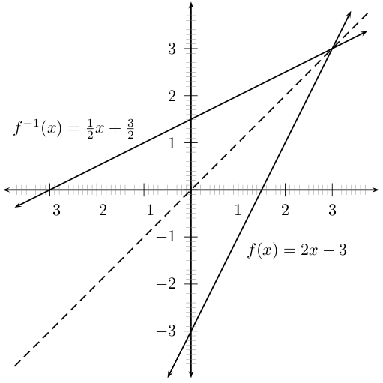| << Chapter < Page | Chapter >> Page > |
In earlier grades, you studied various types of functions and understood the effect of various parameters in the general equation. In this section, we will consider inverse functions .
An inverse function is a function which "does the reverse" of a given function. More formally, if is a function with domain , then is its inverse function if and only if for every we have:
A simple way to think about this is that a function, say , gives you a -value if you substitute an -value into . The inverse function tells you tells you which -value was used to get a particular -value when you substitue the -value into . There are some things which can complicate this for example, think about a function, there are many -values that give you a peak as the function oscillates. This means that the inverse of a function would be tricky to define because if you substitute the peak -value into it you won't know which of the -values was used to get the peak.
This works both ways, if we don't have any complications like in the case of the function, so we can write:
For example, if the function is given, then its inverse function is . This is usually written as:
The superscript "-1" is not an exponent.
If a function has an inverse then is said to be invertible.
If is a real-valued function, then for to have a valid inverse, it must pass the horizontal line test , that is a horizontal line placed anywhere on the graph of must pass through exactly once for all real .
It is possible to work around this condition, by defining a “multi-valued“ function as an inverse.
If one represents the function graphically in a -coordinate system, the inverse function of the equation of a straight line, , is the reflection of the graph of across the line .
Algebraically, one computes the inverse function of by solving the equation
for , and then exchanging and to get
Khan academy video on inverse functions - 1
The inverse function of is determined by solving for as:
Therefore the inverse of is .
The inverse function of a straight line is also a straight line, except for the case where the straight line is a perfectly horizontal line, in which case the inverse is undefined.
For example, the straight line equation given by has as inverse the function, . The graphs of these functions are shown in [link] . It can be seen that the two graphs are reflections of each other across the line .

We have seen that the domain of a function of the form is and the range is . Since the inverse function of a straight line is also a straight line, the inverse function will have the same domain and range as the original function.

Notification Switch
Would you like to follow the 'Siyavula textbooks: grade 12 maths' conversation and receive update notifications?